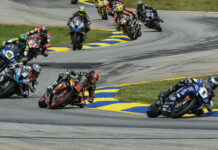From a press release issued by Indianapolis Motor Speedway:
INDIANAPOLIS MOTOR SPEEDWAY OVAL TO BE REPAVED THIS YEAR
Project to begin in August after Brickyard 400
INDIANAPOLIS, Wednesday, March 31, 2004 – The Indianapolis Motor Speedway’s 2.5-mile oval will be repaved after the 2004 Brickyard 400, track officials announced March 31.
The historic oval was last repaved in the fall of 1995. The 2004 repaving will mark the first time the warm-up lanes and current pit lane, which were constructed in 1993 and 1994, respectively, receive new asphalt.
The Speedway’s 2.605-mile road course, which was built in 1999, will not be paved.
According to Kevin Forbes, IMS director of engineering and construction, 36,500 tons of asphalt will be laid in two or three layers, covering 1,085,085 square feet per layer.
The height of the racetrack, and the track’s SAFER Barriers – the energy-absorbing system located on the outside walls in each of the four turns – will not be affected, as 4 inches of the surface will be milled and replaced with an identical amount of new asphalt.
The 9 degrees, 12 minutes of banking in the turns will remain the same. The Speedway oval’s banking and overall configuration will not be altered.
Preliminary work is scheduled to begin Aug. 9, the day after the 11th Brickyard 400, and paving should be completed by mid- to late October, Forbes said. Formal private testing among teams will not likely resume until spring 2005 to allow the new surface to cure over the winter, Forbes said. Hall of Fame Museum track tours will resume within days of the completion of paving.
The Indianapolis Motor Speedway’s racing surface has taken several forms since the track’s construction. The original coal-tar emulsion and crushed stone surface proved dangerous immediately upon the inaugural weekend of racing in August 1909, and 3.2-million paving bricks were laid down in late 1909, giving the track its venerable nickname, “The Brickyard.”
Patches of asphalt were placed on rough portions of the turns in 1936, and by 1939 all but the middle portion of the main straightaway was covered with asphalt.
In 1961, the main straightaway was finally covered with asphalt.
The track did not receive its first comprehensive repaving until summer 1976, and the process was repeated in the summer of 1988 and again in the fall of 1995.
More, from another press release issued by Indianapolis Motor Speedway:
Q&A WITH KEVIN FORBES ABOUT REPAVING
INDIANAPOLIS MOTOR SPEEDWAY OVAL
INDIANAPOLIS, Wednesday, March 31, 2004 – An interview with Kevin Forbes, Indianapolis Motor Speedway director of engineering and construction, about the repaving of the entire 2.5-mile IMS oval starting in August 2004:
Q: When will the project start?
Forbes: Literally the day after the Brickyard (400).
Q: How long will the entire process take?
Forbes: If we start right after the Brickyard 400, we are very hopeful to be done by the middle or end of October.
Q: How long will it take for the track to cure? Will the customary fall IndyCar Series testing be out of the question for 2004, and how long will the Hall of Fame Museum tour buses have to stay off the track?
Forbes: Tour buses won’t affect it at all. I’m sure there will be limited testing on the surface just to validate the characteristics of the surface as far as friction and evenness. But, in terms of multiple team testing and prolonged tire testing, we’d be wise not to do that.
Q: How much asphalt is required? (Square feet, weight, etc.) How deep will it be?
Forbes: Three or four layers of asphalt, weighing a total of 36,500 tons. The total area to be paved is 1,085,085 square feet, or 120,565 square yards, and that will be covered either three or four times.
Q: Is anything being done to the road course? How will this affect Turns 12 and 1 of the road course, where it connects with the oval?
Forbes: The texture will become more similar to the road course itself. As far as making the oval portion closer to the texture and appearance of the road course, it will go a long way in doing that, although the disparity that exists now isn’t a problem.
Q: Will this affect the banking of the oval at all? Will it still be 9 degrees, 12 minutes? How is the challenge of maintaining the banking to precision met?
Forbes: After the existing asphalt is milled away, then we will do some very precise checking of what’s left. Then we’ll make adjustments by additional milling in specific areas to ensure we have a perfectly parallel surface that is 5 ½ inches below what we have right now. We will try to start with a perfectly parallel plain. If it’s not, we’ll adjust it at that point. It becomes a very careful process of paving extremely slow, nonstop, and then we’ll check after every lift (layer) of asphalt is put in place. We’ll check that the geometry is what it used to be.
Q: A commonly used number for the amount of original bricks that remain beneath the asphalt surface is 85 percent. Is that number still accurate?
Forbes: That’s pretty close. When the racetrack was bricked in 1909, obviously the entire track was a ring of brick, before any tunnels were built. The bricks were removed where the tunnels were cut through. We’ve saved, over the years, basically all those bricks. Those are the bricks that will be used to reset the start-finish line.
Q: The SAFER Barrier will be removed in order to do this. Any other affects on the SAFER Barrier?
Forbes: No, it will not be affected. We are taking out 4 inches (of asphalt) and putting in 4 inches. Geometrically speaking, it will be identical.
Q: What have you and the staff learned about repaving technology since 1995? What will be done differently, in terms of applying the asphalt, smoothing, etc.?
Forbes: We will make a few changes. The worst enemy of bituminous pavement is the long-term oxidation of the asphalt cement. Over time, it becomes brittle. When it becomes brittle, it cracks, and that’s the only reason we’re repaving this racetrack right now. It’s not rough. It just has so many cracks in it that in May when the IndyCarÒ Series cars are on the racetrack, with all the suction from the downforce and the track is still somewhat cold from the winter, they actually start to break up little bits and pieces of the track. Very small pieces, and it’s not that many, but just enough to become a nuisance. And if it weren’t for the cracking and resulting net-like matrix of cracks that leads to IndyCar Series cars breaking it apart, we wouldn’t have to repave this. So, in response to that, we’re going to design a pavement, or mix, that will combat the oxidation much better. One other drawback to racetrack pavement is that it has no traffic, which is a very detrimental effect. (You would think) the more pounding it gets, the worse it would be, but the pounding actually closes the cracks back together. On a highway that has a lot of traffic, they (traffic) are continually kneading those cracks together. We don’t have that on a racetrack, so once cracks open up, they stay open. So we’re going to strive to develop an asphalt pavement that will resist the cracking much more so in the future.
Q: Has this type of asphalt mixture that you’re looking for been used elsewhere?
Forbes: Oh, yeah, it is something we’ve used with virtually every track that’s been paved since we repaved in 1995. We learned a lot in ’95 and applied it to racetrack pavements at Kansas City, Chicagoland. We are starting to really understand the dynamics and all the little idiosyncrasies that surround racetrack paving. Even though bituminous asphalt technology has been around since the 1930s, really only in the last 10-15 years or so have we truly begun to understand how it works on a racetrack.
Q: I understand the “high density” asphalt used last time, in 1995, has pros and cons. Can you elaborate on that, and what will be done this time to get an even better result?
Forbes: There are a couple things. You can look at a bituminous mixture as just a bunch of rocks glued together by asphalt. We’re going to change those rocks. We’re going to make them bigger. We used to think that finer (rock) was better; now we think much bigger is better. For so long, racetracks were always worried about trying to produce a smooth and even surface, smooth like glass and even so that doesn’t undulate. It was a smooth texture, like glass, because of the concerns of tire wear. Well, now we know that it’s kind of a myth because tire engineers can develop tires for the most abrasive of surfaces. Even though this isn’t going to be an abrasive surface, it’s going to be a little more abrasive because it’s going to be coarser. A coarser rock structure is more crack-resistant than a fine rock structure. The other thing we’re going to do is change the chemistry of the asphalt cement, or glue that holds the rock together. We’re going to change it so it behaves more like a fluid in extreme cold temperatures so it doesn’t get brittle and crack like glass. We’re trying to stay away from “glass” in every respect. It doesn’t need to be smooth like glass, and we don’t want the surface to be brittle like glass.
Q: The diamond grinding was done in 2002 to preserve the track “for several more years.” Did you anticipate waiting another year or two to repave, or did the grinding do what it was supposed to do?
Forbes: Yes, it did what it was supposed to do. We’ll end up having three seasons of racing on that diamond-ground surface because we’ll have all of next year’s, as well.
Q: How will the surface compare to the diamond-ground surface?
Forbes: It will not be as abrasive as the diamond-ground surface. It will be a little bit smoother.
Q: Clarence Cagle, who was the longtime superintendent at this track, certainly considered one of the Speedway’s legendary figures and a wizard at paving, passed away last July. What are your thoughts on not having Clarence here to be part of this?
Forbes: He’ll be watching. He just won’t be standing alongside. His presence will be felt. I think anybody who was ever around Clarence learned from him. I know I tried to learn as much as I could while we had the opportunity to pave some of these tracks together.
Q: What other tracks have you paved?
Forbes: I wrote the paving specifications for Chicagoland (Speedway), Kansas (Speedway), Pocono (Raceway), Walt Disney World (Speedway), Pikes Peak (International Raceway) and Las Vegas (Motor Speedway). We’ve had various roles in all those tracks. What we refer to as a special paving consultant is a person who watches the paving process and helps the paving contractor understand the differences between standard street-and-highway paving and racetrack paving. The contractor who will end up paving this track is a commercial street/highway paving contractor. We meet with them and oversee their operations from start to finish to help them understand the differences.
Q: Are there any comparisons between highway and racetrack paving?
Forbes: It is not night and day. It is like the difference between assembling a grandfather clock and assembling a wristwatch. All of the processes are similar; they’re just much more fine-tuned for a racetrack. They’re more critical, and not to put down or understate the importance of highway paving, (but) they’re dealing with a whole different set of loading criteria than a racetrack does. The difference is, when a highway asphalt surface fails, it almost never has a life-or-death consequence. When a racetrack pavement fails, it could mean the difference between life or death. There are just tighter controls. Everything is done a little slower.
Q: This track gets praise from drivers in all series that compete here as being one of the smoothest tracks in the world. And this comes even after the asphalt on the track has sustained eight years of abuse since it was last repaved. Now the drivers are about to get a brand-new surface that should be even better. Give your thoughts on the incredible standard IMS maintains with its track surface.
Forbes: Since our track is as flat as it is, it’s easy to pave a flat track, so we should have a smooth track. When you start paving tracks that are in excess, say, of 14 degrees, now you’re talking about another set of equipment just to hold up the paving equipment. When you have one set of machines holding up machines, then you just double the chances for something to go wrong. There’s another reason why we’re going to repave this track. The more cracks there are, the more water gets into the surface. The more water that gets inside the asphalt, it adds more water to the pavement structure, and it makes it difficult to dry the racetrack. So, this will also help the events, in that we can put the show on a lot quicker now so people aren’t in their seats waiting for the track to dry. One of the major benefits of repaving this track is that it’s going to dry much more quickly, and we’re going to get the show back on the stage much more quickly.
More, from another press release issued by Indianapolis Motor Speedway:
INDIANAPOLIS MOTOR SPEEDWAY OVAL SURFACE IMPROVEMENTS TIMELINE
INDIANAPOLIS, Wednesday, March 31, 2004 – A timeline of the original construction and surface improvements to the 2.5-mile oval at the Indianapolis Motor Speedway:
Summer 1909: The Indianapolis Motor Speedway oval was graded, and a surface of crushed rock – smoothed and compacted using rollers and then sprayed with tar – was laid. Several railroad tank cars full of tar were delayed en route, and the process of spraying tar on the track was not completed until early August.
Fall 1909: Several serious accidents in the first weekend of racing convinced Speedway management that the tar-and-crushed rock surface was too dangerous, so the decision was made to resurface the track with paving bricks. Approximately 3.2-million bricks, weighing 9.5 pounds each, were used to complete the job in 63 days from late September through early December. That is an average of 51,000 bricks laid per day. To pave the track with bricks, crews placed a layer of sand on top of the original surface, then set each brick in the bed of sand with about one-quarter inch separation on each side, then poured mortar around the bricks.
Spring 1936: The track received asphalt paving for the first time, when rough portions of the turns were smoothed with asphalt patches.
1937: The four turns were resurfaced with asphalt.
1938: More asphalt was laid, leaving brick exposed only in the middle portions of each straightaway.
1939: The entire track, except for the main straightaway, was resurfaced with asphalt.
1956: All four turns were resurfaced with asphalt.
October 1961: After A.J. Foyt’s first Indianapolis 500 victory, the main straightaway was paved with asphalt. The now-famous “Yard of Bricks,” a 36-inch strip of original bricks at the start-finish line, was kept in place to pay tribute to the Speedway’s famous surface.
1964: The back straightaway and Turn 3 were resurfaced.
July 1969: Track was resurfaced, except areas paved in 1961 and 1964.
Summer 1976: The entire track was repaved, marking the first time a complete repaving took place since the bricks were laid in 1909.
Summer 1988: The entire track was repaved.
Spring 1993: Asphalt warm-up lanes installed in four turns and two short straightaways between Turns 1 and 2 and Turns 3 and 4.
Spring 1994: Pit lane renovated, widened.
Fall 1995: The entire track, except the new pit lane and warm-up lanes, was repaved with a specially designed racetrack asphalt mix featuring very small rocks. The top 5 inches of the track were milled and replaced with the new asphalt.
March 2002: The oval surface was made smoother with a process called “diamond grinding,” which eliminates minor bumps in the asphalt. This marks the first time that the Indianapolis Motor Speedway’s surface was ground so the surface would meet the requirements of high-speed racing.
Maybe Barber Should Ask For Repaving Tips: Indianapolis Motor Speedway To Be Repaved
Maybe Barber Should Ask For Repaving Tips: Indianapolis Motor Speedway To Be Repaved
© 2004, Roadracing World Publishing, Inc.






